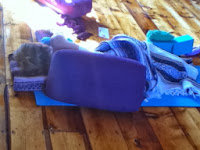It is hip to be square. Last night I was sitting on the porch handing out candy when the nerdiest couple of kids came up requesting said candy. I was looking at their costume of rolled up pants, checkered shirt, suspenders and big black glasses, and I’m thinking they look pretty hip to me. Segue to our practice this week on bringing the focus to our hips by opening them up to ground ourselves in this whirlwind of a season. It is Vata season. See the below video by Banyan Botanicals for some helpful advice to keep you in balance both off and on your mat.
Vata Pacifying Yoga
- Practice at a slow, smooth and steady pace.
- Explore fluidity in your poses. Use gentle movements such as spinal and pelvic undulation, rotation in the joints, counter-poses, and flexion and extension.
- Hold each posture for a short amount of time, but do multiple repetitions.
- Draw into and move from your power center or hara. The hara is the area below the navel and above the pubic bone.
- Focus on the foundation of the pose to create stability.
- Internally rotate the femurs and press into the outer edges of your legs.
- As you move, imagine you are moving through a substance like warm water or warm mud.
- Focus on lengthening your inhalation.
- Stay connected to the earth. Ground down through your big toes.
- Fix your gaze below or at the horizon.
- Engage your entire body by hugging your muscles to the bones.
- Do not over extend or deplete yourself. Your practice should be strengthening, not draining. Vatas easily exhaust themselves and when the vata imbalance becomes severe, a restorative practice is best.
- Be present in your practice.
- Stay warm.
- Conclude your practice with a long relaxation.
http://www.banyanbotanicals.com/yoga/vata
The Breath
Humming Breath (Brahmari)
Benefits:
- Excellent for speeding up the healing of body tissues
- Alleviates stress and tension, anger, anxiety, asthma, insomnia, and high blood pressure
- Strengthens the voice and relieves thyroid ailments
- Benefits are enhanced when practiced after Nadi Shodhana
- Balance air and ether, especially in the vata Fall season (Ayurvedic)
How To:
- Sit comfortably, with lips closed and teeth slightly opened. Make sure the jaw is relaxed.
- Raise the arms to the sides, bend the elbows, and bring the hands to the ears, plugging the ears with the index or middle fingers.
- Bring the awareness to the center of the head (ajna chakra) and keep the body still.
- Inhale through the nose, and while exhaling make a deep, steady humming sound like a bee for the duration of the exhale.
- Then, while inhaling, contract the throat to produce a humming sound on inhalation (if this sound is difficult to make at first, focus only on producing the sound while exhaling).
- Practice 5 rounds, ending with a humming exhale.
The Poses
Mountain Brook
Childs Pose
Nesting Side-Lying Pose
 |
| Can you find the student? |
Benefits; Grounding, well-supported pose to regulate the nervous system, good for when you are feeling anxious, keeps body in alignment, supportive for the spine, hips, shoulders, head. Allows for optimal healing.
Props: bolster, 3-4 blankets, neck pillow
Create a big enough folded blanket to place between the knees to align the legs in Tadasana. Add a folded blanket to rest your top arm on. Recline on a side that is comfortable, resting your head on a blanket. A neck roll can go under the ankles for support. Bolster can rest along spine for further support and grounding. Finally, cover yourself with a blanket from head to toes. Sink down with each long exhalation. Mantra to accompany pose “I am safe, I am supported”.


Leave A Comment